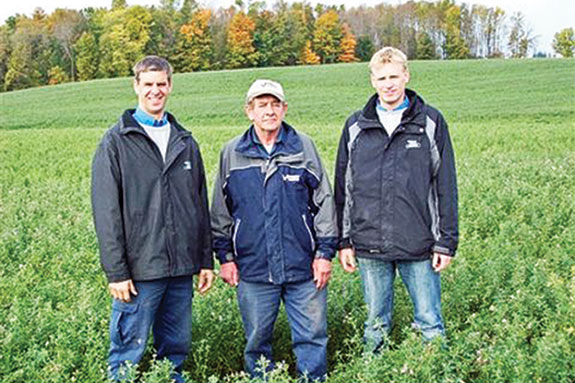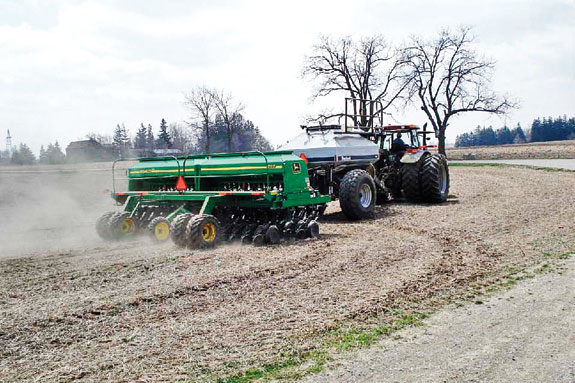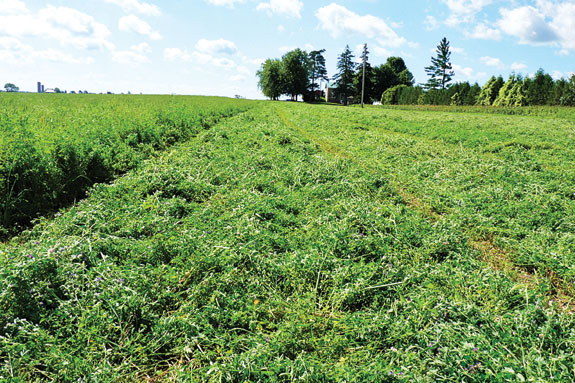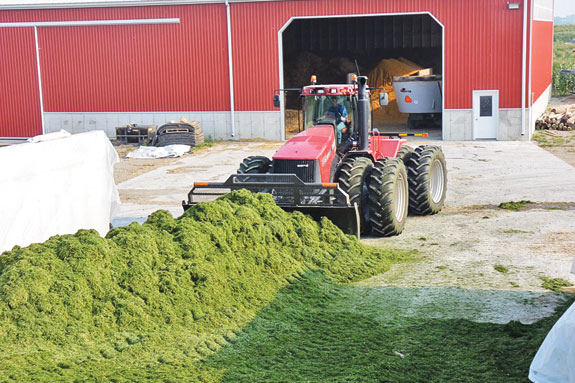An Ontario “forage master,” Evert Veldhuizen, creates his high-quality forage on Veldale Farms along with his brother and nephew.Evert’s mother and father started the farm back in 1966 and had farming in their blood.

“In 1979, a tornado ripped through the area and put the whole operation in jeopardy, but with the help of the community effort put forth, we were able to get back on our feet,” Veldhuizen said.
The crops on Veldale Farms vary in the amount of acres they occupy from year to year. According to an estimate by Veldhuizen, about 200 acres are forage, 650 acres are for corn, 450 acres are for soybeans and 150 acres are for wheat.
Veldale Farms also have 180 dairy cattle with a freestall, sand-bedded barn. Sand bedding creates the most natural environment for the dairy cattle in the barn.

Veldale Farms has five full-time employees, four part-time and one controller. Everyone is kept busy on the operation.
“Good-quality forage is certainly important,” Veldhuizen says. You can get a lot of milk out of dairy cattle by feeding them a non-forage diet, but it’s not going to be a good-quality or sustainable diet.
High-quality forage is a very sustainable, long-term diet to make the cattle healthier in the summer and to keep them cooler as well.
According to Veldhuizen, 70 percent of his feeding ration contains forage. “With a high-quality feeding product you can expect increased milk production as well as lower feeding costs,” he states.
So how do they grow this ideal feed? The first step involves testing the ground. Veldhuizen tests the soil and creates grid maps to see what type of fertilizers and nutrients are needed in specific areas.
He also completes a manure analysis in order to know the exact nutrient content he is spreading.
“Soil is then prepared to ensure a level seed bed,” he explains. “You have to fertilize according to the recommendations and also choose a well-proven, high-yielding certified number one alfalfa seed with a 70/30 mix ratio.” Veldale’s grass choice is 17 percent timothy, 10 percent red canary and 3 percent orchard.
Planting is done “no-till” for soil conservation. Veldale Farms uses about 20 pounds of seed per acre and the lifespan of the field is about four years.
“We monitor our growth until a precise harvest time length of 37 to 38 NDF,” Veldhuizen explains. Veldhuizen also aims to cut and harvest in the same day. When cutting is done, there is no conditioning. The forage is laid out and the sun does the drying.
The benefits of sun drying and no conditioning are that the plant essentially thinks it’s still alive and it still photosynthesizes all the way through.

During the process, you’re not breaking the stem or interrupting the water flow from the stem all the way up to the leaves. That means less leaf loss and also reduces dry matter loss, field traffic and maintains a consistent volume.
Another step included is inoculation, which prevents dry matter loss with a goal of aiming for 35 to 45 percent dry matter. “At the end of the harvest, we also apply the manure,” Veldhuizen said.
After harvesting it is important to properly pack and store the forage product. Proper packing is critical for fermentation. Sidewall plastic, a top seal, bird screen and tires are used to properly cover the material.
The bird screen is placed on top and sandbags are placed on the sides with tires wall-to-wall to cover and help maintain the nutrient value.

After the forage has fermented properly, Ag-Bags are used to store the product.
“It sounds easy to say, but in order to create a high-quality forage product you need to do everything right,” Veldhuizen says.
“You can’t just plant low-quality seed and take care of it and expect it to be a high-quality product. Every part of the process needs to be very well taken care of.”
“We also have a seed dealership and sell to whoever is in need of seed in the surrounding areas,” Veldhuizen says.
Evert traveled from Canada and took second place in the 2011 American Forage and Grassland Council’s annual Forage Spokesperson competition.
As the second-place winner, during his speech, Veldhuizen mentioned a very interesting quote originally used in Thomas Kilcer’s newsletters that is encouraging for all forage producers:
“It is the crops that feed the cows, that make the milk, which creates the money.” PD
PHOTOS: (From top) Evert Veldhuizen (middle) and his sons, Jan (left) and Evert Jr (right), believeevery part of the process is important to producing high-quality forage. To begin, soil tests are completed and fields are prepared for no-till planting of a high-yielding certifed alfalfa blend seed.
At a precise harvest time of 37 to 38 NDF, forage is cut and laid out in wide swaths for drying in the sun. This results in less leaf loss, reduced field traffic and maintains a consistent volume.
The final step, packing and storage, is critical for proper fermentation and maintaining nutrient values. Photos courtesy of Evert Veldhuizen Jr.




